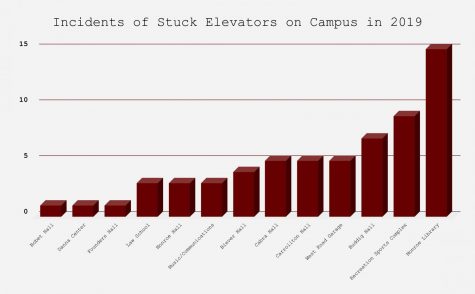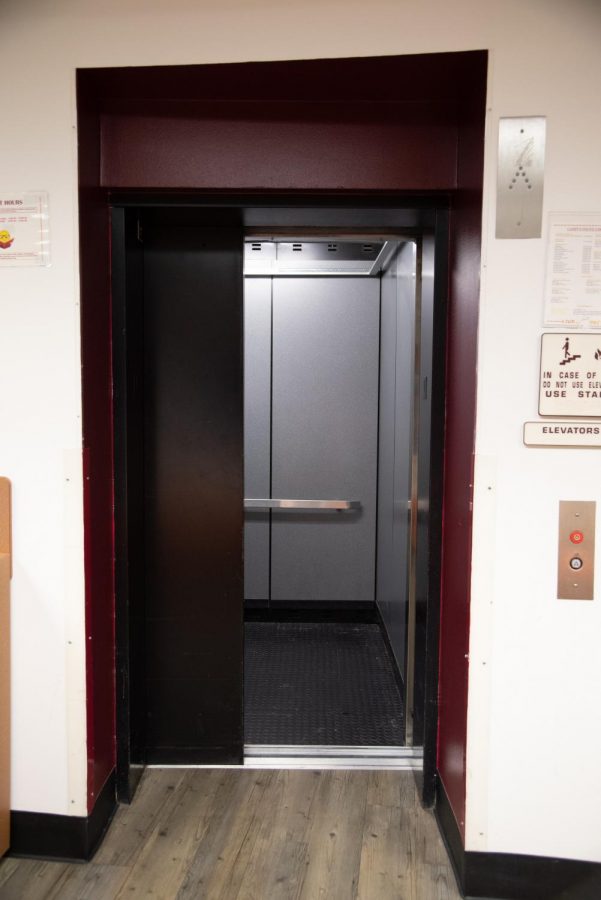Campus elevators leave some stranded
An elevator opens it doors in Carrollton Hall. Loyola elevators broke down 62 times in 2019, but authorities say the university is following state inspection policies. Photo credit: Michael Bauer
January 31, 2020
Joseph Sabados turned 18 during his freshman year in 2017, surrounded by friends serenading him with ‘Happy Birthday’ when the clock struck midnight after a night out celebrating. But it wasn’t the pivotal age that made Sabados’ entrance into adulthood memorable, it was the location of the celebration. Sabados turned 18 while trapped in an overcrowded Buddig Hall elevator, along with 12 of his friends.
“We were there for like an hour just breathing the same air,” Sabados said. “You could feel the condensation on the walls. When we finally got help, we were just like ‘Please let us get fresh air, like cold air.’”
Sabados said he and his friends knew they had gone over the elevator’s maximum capacity of 12 passengers, but they had thought nothing of it until the elevator went below the first floor, leaving the college freshmen trapped below ground floor for over an hour.
After calling LUPD and being rescued by maintenance workers, Sabados swore off riding elevators. But not for long.
“I told myself the first time it happened, that I was never going to do it. But the next day, I got on one,” Sabados said.
That decision led Sabados, who is now a junior, to add two more tallies to his list of trapped elevator experiences. He got stuck once in the Communications/Music Complex on the way to class and again in the West Road Parking Garage during the heat of summer, for a few minutes each time.
But Sabados is not the only student with experience getting stuck in Loyola elevators.

Data obtained from Loyola University Police Department
In the 2019 calendar year, there were 62 instances of stuck elevators between Loyola’s two campuses and 33 elevators, a statistic that Todd Warren, chief of police at Loyola, said was surprisingly high, especially considering that 15 of these incidents were in Monroe Library.
“We had quite a few last year. All were resolved fairly easily,” Warren said of stuck elevators on campus.
But Warren said that while he feels for those who have found themselves in an elevator that fails to, well, elevate, these incidents don’t seem to indicate a larger safety or maintenance issue with Loyola’s elevators, just what he said appears to be an unfortunate fact of life on campus.
“I couldn’t find a pattern or, really, a cause. It’s just not as uncommon as I originally thought it was,” Warren said. “There’s a lot of reasons for them (getting stuck) that vary from overloading the car, to just needing maintenance to anything mechanical breaking.”
Bass Barfield, service sales representative at elevator company KONE Corporation, said that how often an elevator gets stuck depends on its age, the frequency of its use as well as factors such as common overcrowding. But, on average, Barfield said the typical elevator will make about three and a half emergency response calls per year.
Warren said most incidents of stuck elevators at Loyola can be resolved in just a few minutes. The average duration of a stuck elevator incident was about 24 minutes in 2019.
Because of this, Warren said LUPD has worked on decreasing its response time to incidents of stuck elevators, even if they are after hours. The university keeps elevator technicians on campus a couple of times a week to address elevator incidents as they pop up, according to Warren.
“In my research, I think we are doing all we can do. I don’t know that our units are really old, they are maintained well,” Warren said.
Thomas Raymond, director of physical plant at Loyola, said the elevators on campus are not maintained on any particular schedule, just as needed.
Barfield said that while the law in New Orleans only requires annual elevator inspections, he recommends that buildings have scheduled periodic visits by maintenance workers.
“You should have scheduled period visits. The best practice is quarterly maintenance visits on units,” Barfield said. “You should have a technician on site examining, maintaining, adjusting and lubricating the equipment and making sure there is nothing majorly wrong that needs a separate prepared proposal.
While he said he believes the university and LUPD are doing everything right when it comes to stuck elevators, Warren said he feels for the likes of Sabados who is just hoping he has maxed out his life’s worth of trapped elevator experiences.
“I certainly understand and am sympathetic to the inconvenience, because I certainly wouldn’t want to be in one,” Warren said.







